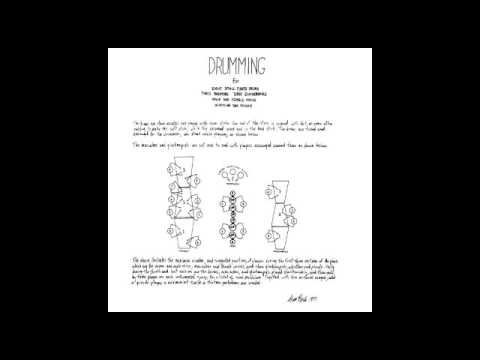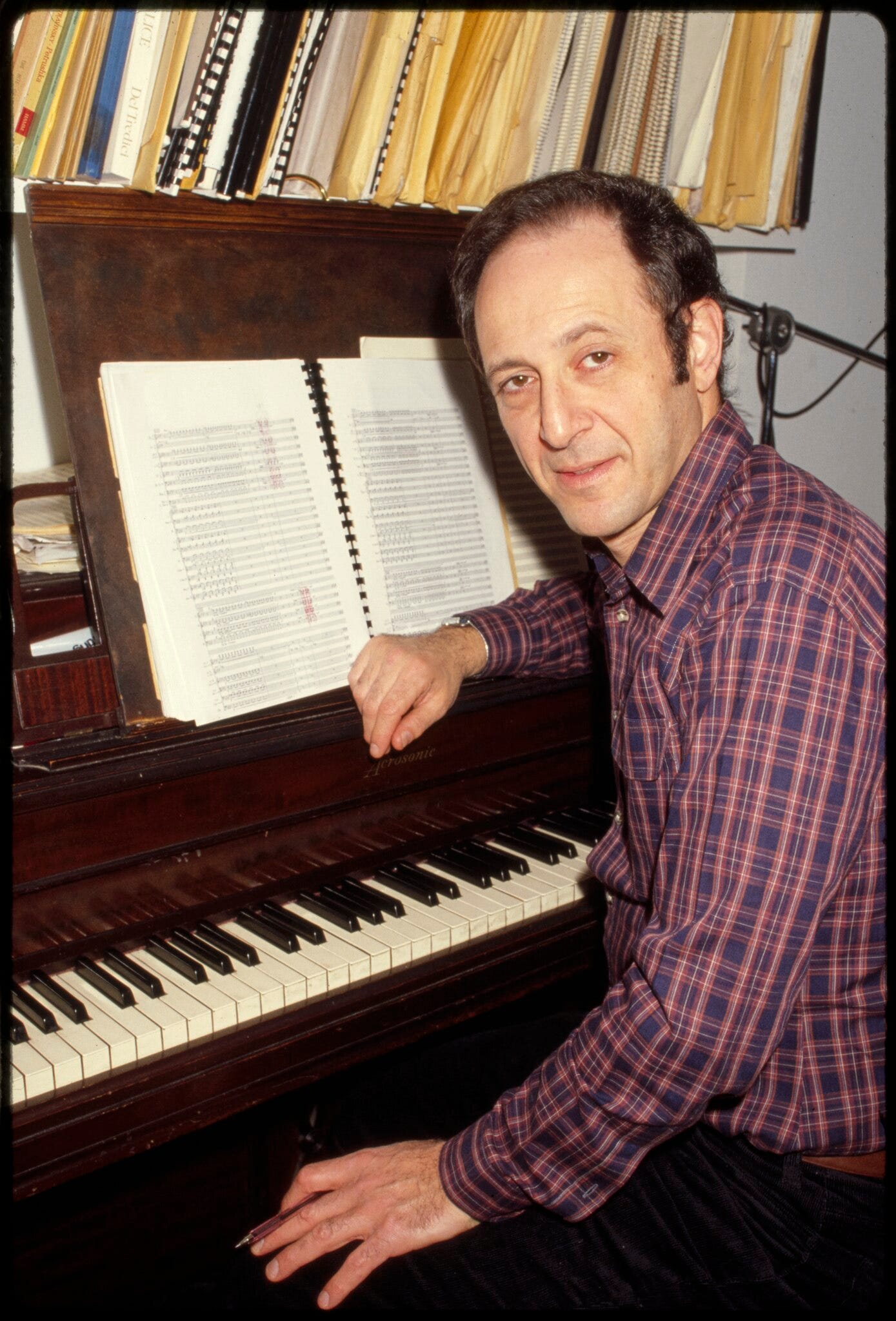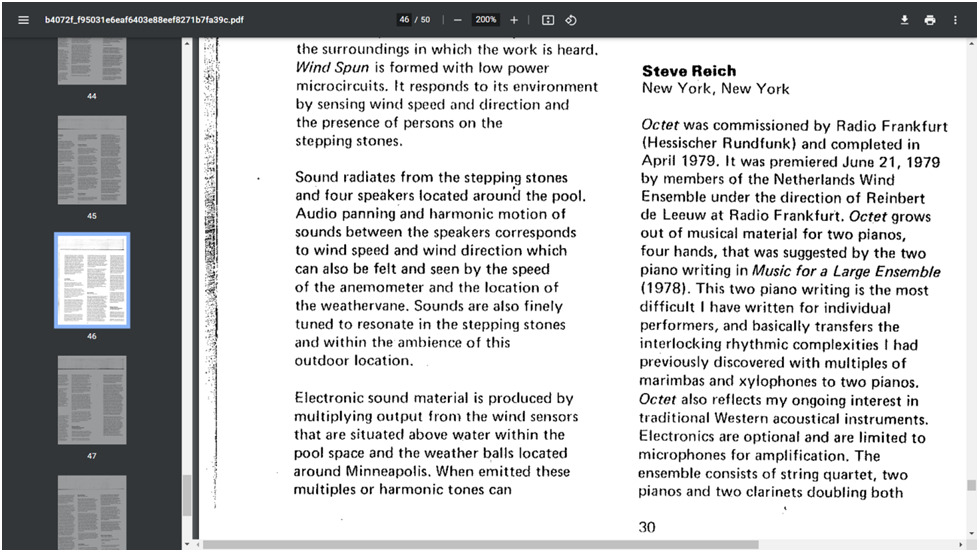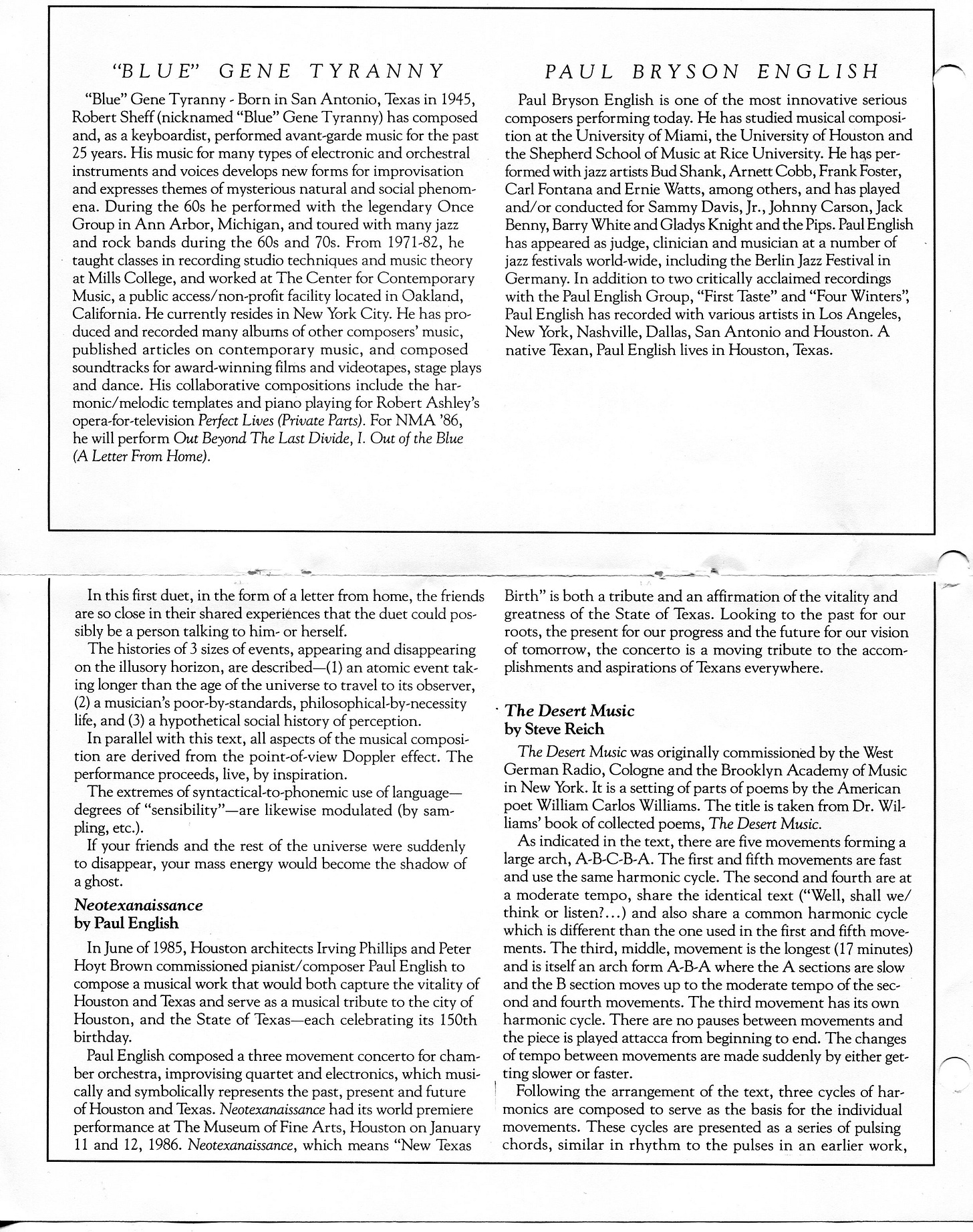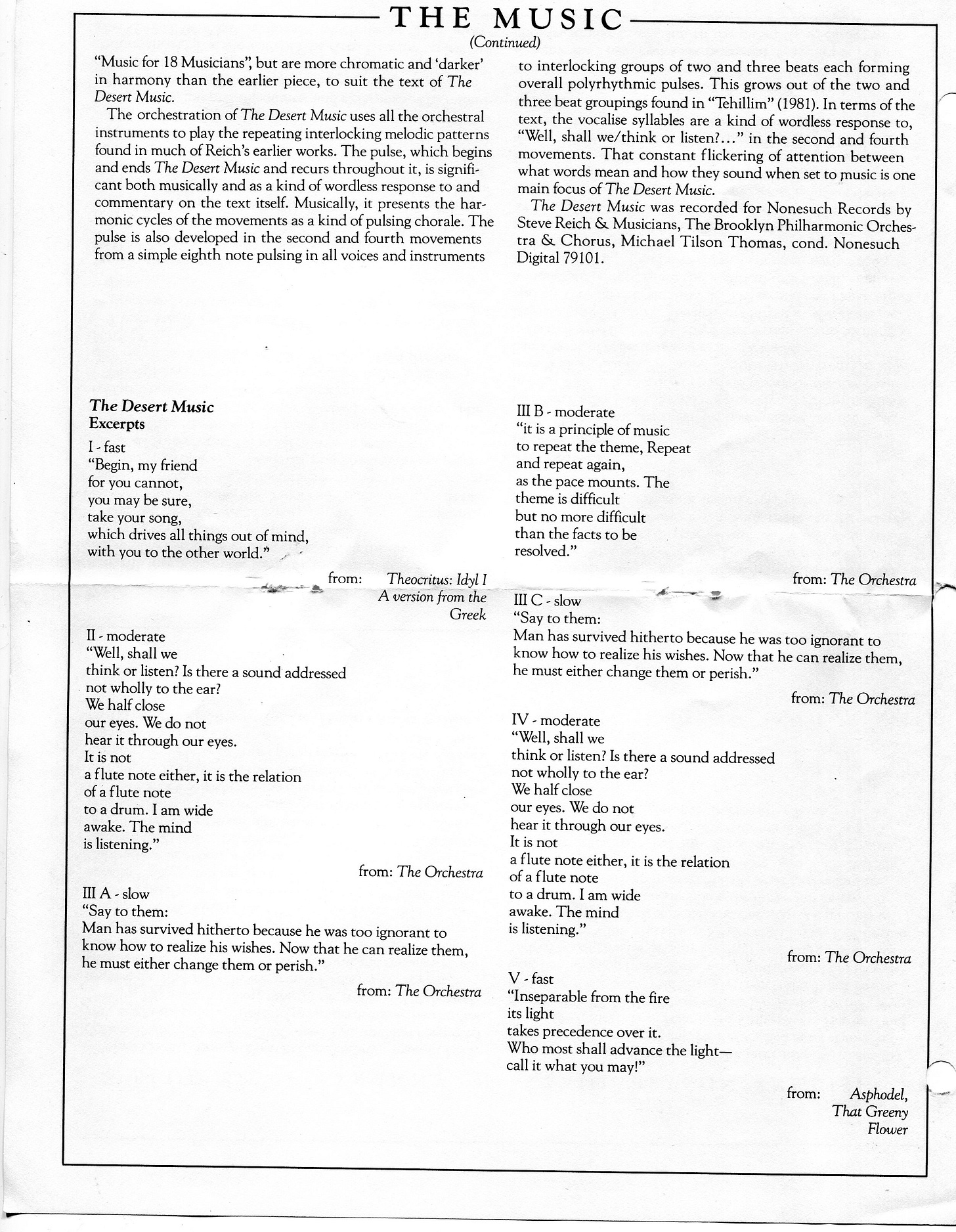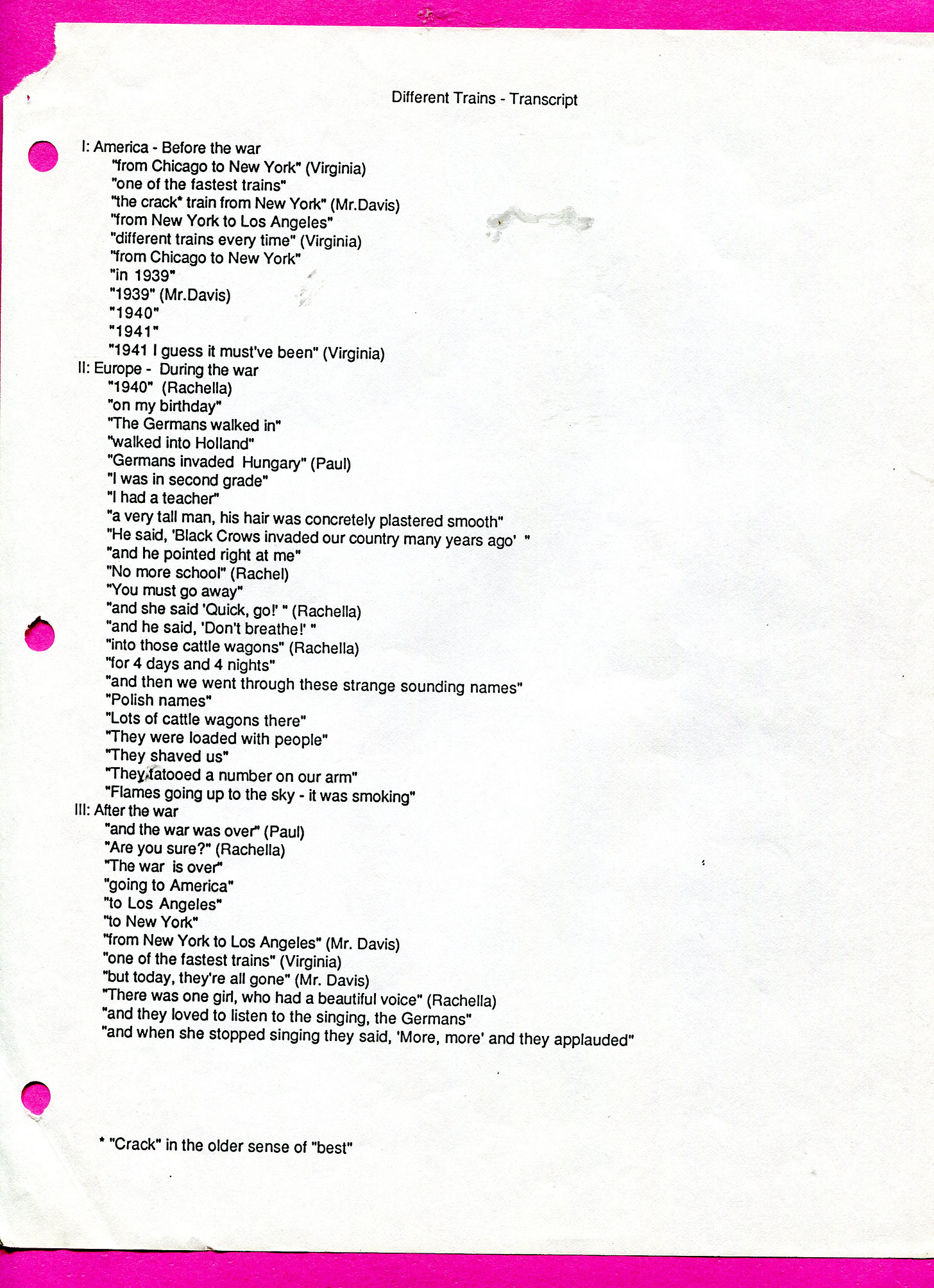October 3 = 1936 Steve Reich; 1943 William McGlaughlin; 1946 Robert Snyder
The big first concert was on June 8, 1979 at New Music New York and Steve Reich and his ensemble were the first ever performers at New Music America on a night shared with Pauline Oliveros, Philip Glass, Meredith Monk and Robert Ashley. There is a 14 minute recording of that performance on the Kitchen retrospective double CD (which I don’t have) featuring David Van Tieghem, Gary Schall, James Preiss, and Richard Schwarz, but the y2b offers up a recording from 1971, and includes all four parts and a very large ensemble featuring many names who would appear at future NMA festivals.
Steve Reich - Drumming (Part One)
(“Minimal Effort” y2b account, vinyl rip of 1972 limited edition of 500 produced by Jon Gibson and Multiples Inc.)
*
After all these years, Mr. Reich is too fucking loud. Men hitting things. I remember hearing this piece in 1973 in a big church in Berkeley and it was voluptuous. His music needs a hall with high ceilings and rugs.
Aside from the sound, the formality is reassuring - rather like having your parents stay together for your sake. Comforting, but bad for the stomach. But, it’s fun for the players - wearing black shirts and getting off beating skins.
- Beth Anderson, Report from the Front
*
Reich was represented by members of is ensemble, four percussionists who played Part 1 of Drumming (1971), an important work of the movement that grew from his experiences studying with a master drummer of Ghana. The four drummers tossed the piece off at such a speed that many of the nuances were thrown away.
- Charles Ward, Houston Chronicle
*
Reich steals the show with a rattling, thrillingly visceral performance of the first part of his epochal Drumming.
- Tim Page, Washington Post (on reviewing the Kitchen CD in 2004)
*
…back to the good old days before Glass got all pretty on us. On the other end of the album is Steve Reich’s Drumming, Part I, a piece that was eight years old at the time of recording and that still hasn’t lost its edge.
---- Quinn, American Record Guide, April 2005, reviewing the recording:
*
The trouble with these benefit or festival potpourris is that composers whose work needs time or large ensembles aren’t usually heard at their most characteristic. The first part of Mr. Reich’s Drumming, for instance, exemplifies his rhythmic interests, but it doesn’t get into the coloristic variety of later sections in the same score.
- John Rockwell, NY Times review published June 10
===================================
1980: St. Paul Chamber Orchestra - Reich Octet (8 Lines)
Steve Reich would have a work open the 1980 Minnesota festival the next year as well, although this time it was the St. Paul Chamber Orchestra with Dennis Russell Davies and William McGlaughlin who not only makes his only NMA appearance, it’s his birthday as well! It seems that he’s also become a radio personality over the years whilst still continuing his own compositional forays.
Steve Reich: Octet (later renamed as Eight Lines)
Nonesuch via y2b, Bang on a Can version from 1997
Program notes
This work would also be one of the rare compositions to be performed twice at NMA, but it came much later as performed by the Nouvel Ensemble Moderne at Montréal Musiques Actuelle 1990 New Music America.
*
Steve Reich was represented by his Octet, the 43-year-old New Yorker’s sequel to “Music for 18 Musicians” and the forerunner of his “Music of Large Ensemble”. Pleasant – once again – and free of anything that would engage the heart or mind, the work takes a simple, whistling bit, repeats it ad ostinatum, with small changes occurring in two or three minute intervals. Then the music stops.
- Janos Gereben, San Francisco Examiner July 7:
*
Two of the three pieces on the chamber orchestra's opening-night concert were commissions. Unfortunately, the festival opened with one of those commissions, a weak, derivative and rather giddy piece by Minnesota's Homer Lambrecht called "Owl." But then there was Steve Reich's characteristically ingenious Octet, played brightly and industriously by a hardworking band of orchestra members.
- John Rockwell, NY Times: “Avant-Gardists Get a Chance to Roam” June 9, 1980
Wikipedia details on the work (which was renamed Eight Lines)
https://en.wikipedia.org/wiki/Eight_Lines
Timothy Judd’s Listeners Club blog analysis of the work:
https://thelistenersclub.com/2022/09/02/steve-reichs-eight-lines-octet-cantillation-meets-pulse/
==============================
And for the third time, a Steve Reich work would open a NMA festival, this one in Chicago for the opening night of the 1982 festival, and performing his Tehillim was the Chicago Symphony Orchestra:
Chicago Symphony Orchestra - Steve Reich: Tehillim
The program entry for Steve Reich’s biography and the details about the work Tehillim are extensive, so I’ll refer you to page 36 of the photocopied (and pdf’ed) 1982 which can be found here at the late Michael Galbreth’s tribute to New Music America (he was the co-director of Houston 1986), and where you can find downloadable reproductions of the first five festivals held in NYC, Minneapolis, San Francisco and Washington and of course Chicago.
https://www.michaelgalbreth.com/_files/ugd/b4072f_0e552d7000614f6a931d717fad9f8ba7.pdf
Excerpt from the above:
In contrast to most of my earlier work, Tehillim is not composed of short repeating patterns. Though an entire melody may be repeated either as the subject of a canon or variation, this is actually closer to what one finds throughout the history of Western music. While the four-part canons in the first and last movements may well remind some listeners of my early tape pieces It’s Gonna Rain and Come Out, which are composed of short spoken phrases repeated over and over again in close canon, Tehillim will probably strike most listeners as quite different than my earlier works.
There is no fixed meter or metric pattern in Tehillim as there is in my earlier music. The rhythm of the music here comes directly from the rhythm of the Hebrew text and is consequently in flexible changing meters. This is the first time I have set a text to music since my student days and the result is a piece based on melody in the basic sense of that word. The use of extended melodies, imitative counterpoint, functional harmony and full orchestration may well suggest renewed interest in Classical, or more accurately Baroque and earlier Western, musical practice. The non-vibrato, non operatic vocal production will also remind listeners of Western music prior to 1750.
However, the overall sound of Tehillim and in particular the intricately interlocking percussion writing which, together with the text, forms the basis of the entire work, marks this music as unique by introducing a basic musical element that one does not find in earlier Western practice including the music of this century. Tehillim may thus be heard as traditional and new at the same time.
- Steve Reich, from his program notes
***
Archival recording saved and preserved on cassette for 41 years (with thanks to Kyle Gann):
***
The performance of Steve Reich's Tehillim displayed his latest interest in Hebrew chant technique and provided insight to a twist in his compositional style. The work, scored for four vocalists and chamber orchestra, was based upon an additive rhythm process similar to that of his earlier work (i.e., the musical texture is dominated by repetition of a single musical idea; lengthening or shortening the pattern causes a noticeable alteration in the work's slowly evolving design). However, in contrast to Reich's earlier music, in which the voice contributed only as another instrument in the musical texture, Tehillim featured the voice in a solo role while instrumental forces acted as accompaniment. Thus, Reich's musical ontology has shifted emphasis. One's perceptions of time passing were guided by text definition rather than by cycles of repeated patterns.
- Deborah Campana "Two Reports" Perspectives of New Music, Autumn 1981
***
The evening closed with Steve Reich's recent work, Tehillim, a compo- sition that represents several significant departures from his previous work. Scored for 4 women's voices, percussion, 2 pianos, 2 organs, strings and winds, the piece is a setting of a number of psalms in Hebrew, the first time Reich has used text in any of his post-student compositions. As a result the work involves melody as well as the shorter repeating patterns that are characteristic of Reich's output. The melodies are composed without regard for fixed meter or pattern, the rhythms are determined by the Hebrew text. Because of these approaches, the role of the singers is elevated to that of soloists, unlike the textural function of previous Reich vocal parts. The work is celebratory and fun, with much use of handclaps, tuned bongos, maracas and tambourines. Getting through the 25-minute piece was an act of endurance, not for the listener but for the singers (Jay Clayton, Rebecca Armstrong, Cheryl Bensman, Pamela Wood) and players, who waned noticeably towards the end. That, added to the general intonation problems in the orchestra, made the performance less than definitive, however enjoyable.
- Carl Stone, "Two Reports" Perspectives of New Music, Autumn 1981
***
The successful realization of "The Silence..." revealed the inherent religiosity of the piece in strong contrast to Steve Reich's Tehillim, a rather unsatisfying minimalist adaptation of four Psalms.
While one can appreciate Reich's new metrical freedom and the obvious content of this work, Tehillim was uninspiring. The extensive rhythmic variety diluted the characteristic mysterium tremendum of Reich's earlier compositions.
Whatever his present concerns, Reich's influence at New Music America was pervasive, even among the New Wave rockers.
- M. Staff Brandl + Thomas Emil Homerin, "Big Noise from Lake Michigan", Ear Magazine 1982
***
Steve Reich's Tehillim - like everything else on the program, a Chicago premiere - has been heard in New York. Despite some insecurities from the players, Mr. Davies's performance had verve and intensity. The piece itself sounded thin; perhaps the orchestral version to be heard with the New York Philharmonic in September will correct that - but lively, too.
- John Rockwell, “New Music Takes Festival to Chicago”, NY Times, July 7, 1982. (Did he have to point out that yeah, this came to NY already? - gd)
***
Jay Clayton was also involved in performing another work at the festival.
It was Steve Reich's work Tehillim, which was performed by members of The Chicago Symphony Orchestra. With his usual precision, Steve Reich has once again written an extremely successful work. A beautiful and fascinating piece, written for 4 female voices, piccolo flute, oboe, French horn, 2 clarinets, electric organ, 2 violins, viola, cello, double bass (the strings are amplified) and 6 percussionists.
The text for the piece Tehillim (the first piece with text that Reich has created since his student days) consists of some Hebrew psalms: "tehillim" is the Hebrew word for "psalms". Apart from the fact that some of the percussion instruments used in the piece were also used in biblical times in the Middle East, the piece has no particularly "musicological" content - even though Reich has studied Hebrew church singing in Israel and New York in recent years, but it is not only Reich's use of a text that makes this new piece unique in his production: the piece does not consist of repeated figures, unlike his previous works, and a slow movement is also included in the piece.
- Wayne Siegel, “Rapporter: New Music America Festivalen 1982” (original Dutch, google translation), DMT Seismograf, 1982
Alarm Will Sound’s version on y2b posted by “Lilium Laminae”
===================================
In 1986 at the Houston Festival, the Texas Chamber Orchestra under the baton of Tania Leon performed Steve Reich’s The Desert Music on a bill that featured on the first half works by “Blue” Gene Tyranny, Paul English and Malcolm Goldstein. These were the program notes:
This is the version recorded around that time featuring Michael Tilson-Thomas and the Brooklyn Philharmonic, both who would appear at the festival separately in later years.
=======================================
And at the Miami 1988 festival, we got to hear two of his works, the first, another opening night gala performance was (I presume only one of) The Four Sections, performed by the New World Symphony, and this is where Michael Tilson-Thomas gets added to the NMA Alumni.
Later in that same festival, we all were privileged to be at the world premiere of Reich’s Different Trains performed by the Kronos Quartet. I kept my precious liner notes for that night, but that will soon be going to the NMA archives in Houston for other people/fans to check out!
Nonesuch did a short documentary on the re-release of the album:
And the 1988 album which paired it with a work by Pat Metheny:
Reich himself would appear one more time but it was to introduce both an excerpt from Different Trains during the big gala opening of NMA 1989 in New York City. He would also be the person who presented Moondog to all of us at that gala at the Brooklyn Academy of Music.
===========================
Robert Snyder, 1946
Finally, I don’t have any information on the sound installation that Robert Snyder presented at NMA 1982 Chicago, but that’s what research grants are for and he seemed to be easy enough to find via Wikipedia… He (or his work) performed at the Munson Street Garage, a service station converted into an art space.

